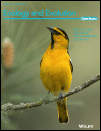A deep dive into timely panda data
Add Summary

The elusive and shy giant pandas live a solitary life, out of the prying eyes of civilization.
That is until a few started sporting GPS collars, then GPS collars with accelerometers. Suddenly, data flows and minutia of a panda’s once private days spring to life – or at least spring to pretty intense, brightly colored graphs that shed light on how pandas mosey about, and how that relates to some pretty personal matters, as well as the conditions around them.
In “Modeling activity patterns of wildlife using time-series analysis” in the journal Ecology and Evolution, scientists from Michigan State University (MSU) and China used, for the first time, wavelet coherency analysis to sync how the pandas were moving with air temperature and the amount of sunshine around them.
The data was gleaned from the GPS collars on five pandas – four females and one male – in the Wolong Nature Reserve from 2010 to 2011. Those collars have already served up revelations about how pandas move through the dense mountains of southwestern China.
The time-series analysis allows scientists to take a more detailed look at how and when the animals were active, and how that varied by seasons.
Studying activity patterns reveals more than just knowing when an animal sleeps or eats. It also reveals insights into behavioral theory and about how animals respond to their own unique ways of getting the resources they need. Such information is useful to those setting policy to protect vulnerable species.
For instance, researchers were able to analyze how the movement of Mei Mei, the one pregnant panda, changed, providing a rare opportunity to test ideas about how pandas behaved during the breeding period. “It makes sense that Mei Mei’s activity level was significantly higher during the spring she was pregnant than the same period in the next year, as she had to build up a storage of energy during the pregnancy,” notes primary author Jindong Zhang, a research associate in MSU’s Center for Systems Integration and Sustainability (CSIS). He also is an associate professor in China West Normal University.
In addition to Zhang, the paper was written by Vanessa Hull, Zhiyun Ouyang, Liang He, Thomas Connor, Hongbo Yang, Jinyan Huang, Siqiang Zhou, Zejun Zhang, Caiquan Zhou, Hemin Zhang and Jianguo Liu, Rachel Carson Chair in Sustainability and CSIS director.
The work was funded by the National Science Foundation, NASA, the National Natural Science Foundation of China, Michigan AgBioResearch, the Michigan State University Distinguished Fellowship Program, and the William W. and Evelyn M. Taylor International Engagement Program.



 Print
Print Email
Email

